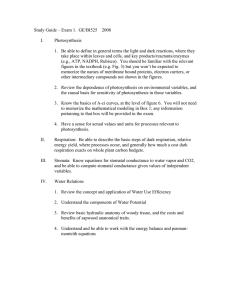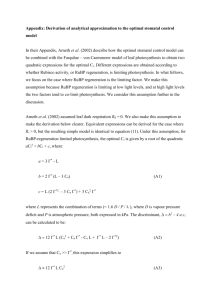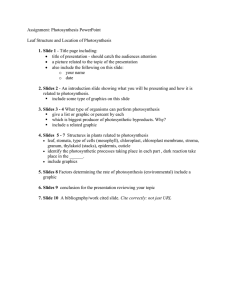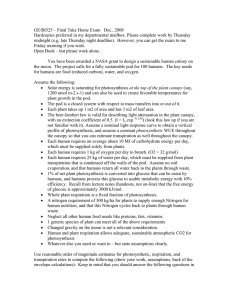Environmental Limitations to Photosynthesis in Sllbalpine Plants of the Central Rocky Mountains, USA
advertisement
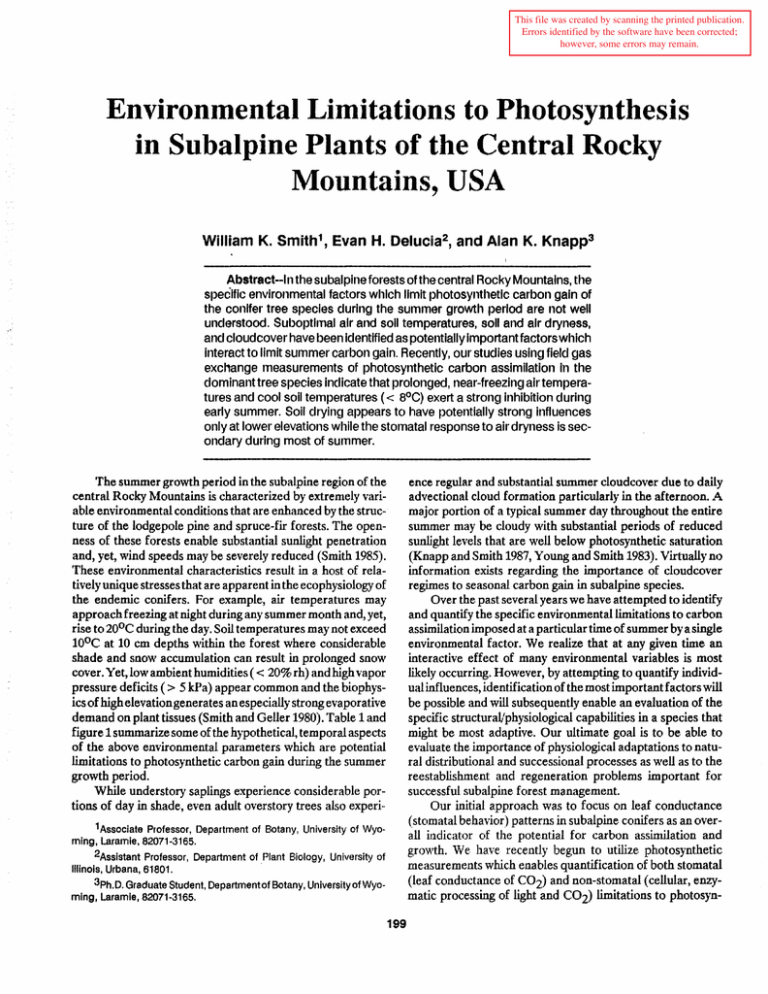
This file was created by scanning the printed publication. Errors identified by the software have been corrected; however, some errors may remain. Environmental Limitations to Photosynthesis in Sllbalpine Plants of the Central Rocky Mountains, USA William K. Smith 1 , Evan H. Delucia 2 , and Alan K. Knapp3 Abstract--In the subalpine forests ofthe central Rocky Mountains, the specific environmental factors which limit photosynthetic carbon gain of the conifer tree species during the summer growth period are not well understood. Suboptimal air and soli temperatures, soli and air dryness, and cloud cover have been Identified as potentially Important factors which interact to limit summer carbon gain. Recently, our studies using field gas exchange measurements of photosynthetic carbon assimilation h, the dominant tree species indicate that prolonged, near-freezing air temperatures and cool soil temperatures « aOC) exert a strong inhibition durin~1 early summer. Soil drying appears to have potentially strong influences only at lower elevations while the stomatal response to air dryness is secondary during most of summer. The summer growth pe.riod in the subalpine region of the central Rocky l\fountains is characteri2.ed by extremely variable environmental conditions that are enhance.d by the strueture of the lodgepole pine and spruce-fir forests. The openness of these forests enable. substantial sunlight penetration and, yet, wind speeds may be severely reduced (Smith 1985). The.se environmental characteristics result in a host of relatively unique stresses that are apparent in the ecophysiology of the endemic conifers. For example, air temperatures may approach freezing at night during any summer month and, yet, rise to 200 e during the day. Soil temperatures may not exceed 100 e at 10 cm de.pths within the forest where considerable shade and snow accumulation can result in prolonged snow cover. Yet, low ambient humidities ( < 20% rh) and high vapor pressure deficits (> 5 kPa) appear common and the biophysics of high elevation generates an especially strong evaporative demand on plant tissues (Smith and Geller 1980). Table 1 and figure 1 summarize some of the hypothetical, temporal aspects of the above environmental parameters which are potential limitations to photosynthetic carbon gain during the summer growth period. While unde.rstory saplings experience conside.rable portions of day in shade, even adult overstory trees also experi·· ence regular a.nd substantial summer cloud cover due to daily advectional cloud formation particularly in the afternoon. A major portion of a typical summe·r day throughout the entire summer may be cloudy with substantial periods of reduced sunlight levels that are well below photosynthetic saturation (Knapp and Smith 1987, Young and Smith 1983). Virtually no information exists regarding the importance of cloud cover re.gimes to seasonal carbon gain in subalpine species. Over the past several years we have attempted to identify and quantify the specific e.nvironmentallimitations to carbon assimilation imposed at a particular time of summer by a single environmental factor. We realize that at any given time an interactive effect of many environmental variables is most likely occurring. However, by attempting to quantify individual influences, identification of the most important factors will be possible and will subsequently enable an evaluation of the specific structuraL'physiological capabilities in a species that might be most adaptive. Our ultimate goal is to be able to e.valuate. the importa.nce of physiological adaptations to natural distributional and successi.onal processes as well as to the reestablishment: and regeneration problems important for successful subalpine forest management. Our initi.al approach wa.s to focus on leaf conductance (stomatal behavior) patterns in subalpine conifers as an overall illdicator of the potential for carbon assimilation and growth. We have recently begun to utilize photosynthetic measurements whi.ch enables quantification of both stomatal (leaf conductanc.e of C02) and non-stomatal (cellular, enzymatic. processing of light and C02) limitations to photosyn- 1Associate Professor, Department of Botany, University of Wyoming, Laramie, 82071-3165. 2Assistant Professor, Department of Plant Biology, University of . illinois, Urbana, 61801. 3ph.D. Graduate Student, Departmentof Botany, UniversityofWyoming, Laramie, 82071-3165. 199 Table 1.--Hypothetical interaction between plant and environmental water parameters within the sprucefir zone during the growth season. Double asterisks indicate a primary limiting effect, either directly on stomatal opening (stomatal) or indirectly through limitations on water uptake from soil and/or movement to the leaves (recharge). Single asterisks denote important, but less significant effects. Based on the interactive model proposed by Smith et at (1984). Late spring Early summer Midsummer Late summer Fall stoma- re- stoma- re.. stoma.. re- stoma- re- stoma- re .. tal charge tal charge tal charge tal charge tal charge Air temperature Soli temperature at root depths Morning xylem pressure potential Afternoon xylem pressure potential Soil water potential at root depths Leaf-air water vapor deficit ** * ** * ** * * * ** * * * thetic carbon assimilati.on (Jone~ 1985). Although stomatal function is especially appropriate for water relations studies, photosynthetic limitations due to non- stomatal jnfluences are often of e.qual if not gre.ater importance (Farquhar and von Caemme.rer 1982). * * * * ** * and Holli.nger (1987) provide a recent and detailed review of this approach. Also, the references provided in the following sections include. detailed descriptions of the spe.cific methods and materials corresponding to an indicated data set. Results and Discussion 1\lethods and 1\laterials All measurement sites were located in the l\ledicine Bow l\lountains of southeastern \\'yoming. The domi.nant conifers include lodgepole pine (Pinus contorta Doug!. ex Loud. ssp. latifolia (Engelm.», subalpine fir (Abies lasiocarpa Nutt.), and Engelmann spruce (Piccaengcimannii Parry). Data pre.sented in the following sections are based primarily of field gas exc.hange instrumentation utilizing cuvettes that enclose branch tips, including primary and/or secondary shoots. Smith ~==::!:::::;--,--~----,---.,..----, TMAX over 10,000' 3,048m TMIN TSOIL AVPD '" SOIL below 9,000' 2,743m T MAX Although numerous studies have dealt with the influence of specific environmental factors on photosynthetic performance, (see Jarvis 1980, Schulze and Hall 1982 for reviews) only a few have attempted a comprehensive evaluation of the rela.tive importance of different environmental constraints at diffe.rent times of the growth peri.od to seasonal carbon gain. Many of these latter studies have focused on stomatal conductance pa.tterns without photosynthetic me.asureme·nts (Kaufmann 1982a,b; Smith e.t a1.1984, Smith 1985a). Stomatal behavior patterns appear to be. strongly influenced by photosynthetic photon flux density (PPFD), plant wate·r status (xylem pressure· potential, XPP), the leaf-to-air vapor deficit (LAVD), and leaf temperature (fig. 2). In addition, nonstomatal limitations may also involve I'PFD and water status, as well as other factors such as carbohydrate feedback inhibition and hormonal effects that have direct consequences on the cellular processing of light energy and the carboxylation process (De.1ucia 1986). TMIN TSOIL AVPD 11 Air and Soil Temperature ~~:....L~.L..I.~:..L.0.L..1.m~ L-_ _ ~--------~M7~n It has been proposed that the temporal sequence of whic.h specific. environmental parameter is most limiting to photosynthesis may proceed as depicted in figure 3 (Smith 1985b). Initially in early summer, the continuing (a.lthough sporadic.) occurrence of near-free.zingnights causes a major reduction in stomatal opening and photosynthesis on subsequent days (Delucia 1987, Fahey 1979, Neilson et al. 1972, Pharis et a1. 1~________~~~~ '" SOIL JUNE JULY AUGUST Figure 1.--A hiers.rchisl model of envlr'onmentaillmlta.tlons to photosynthesis In Engelmann Spl'UCI:t. The hatched bars indicate a strong limitation (> 20%) and the open bars indicate a slight limitation (5 to 10%) to photosynthesis at high l2:. 10,000 feet, 3048 m) and low (..$. 9,000 feet 2743 m) eleva.tlolls. 200 1970, Smith et a1. 1984, Smith 1985a). Cold air drainage may extend low nighttime needle temperatures to lowe.r elevations (Kaufmann 1984a). Figure 4 shows the fairly dramatic. i.ncrease in leaf conductance and net photosynthesis for four subalpine conifers immediately following the onset of above .. freezing nights in June. Prior to this disappearance of belowfreezing ni.ghts, it appears that the capacity for net photosynthesis is approximately half of the maximum rates measured during summer (Delucia and Smith 1987) while leaf conductance may also be severely depressed to even lower va.1ues relative to maximum seasonal levels (Smith 1985b). Similar reductions in leaf conductan~e has been reported for six subalpine conifers after the onset of freez.ing nights in fall (Smith et a1. 1984). In contrast, low daytime aii temperatures appear to have a minimal impact compared to nighttime minimums, at least for clear days. Consi.derable warming of conifer nee.dles above air temperature under full-sun conditions results i.n temperatures that are within a relatively broad and high temperature range for maximum photosynthesis (Delucia and Smith 1987, Smith and Carte.r 1987). Optimal temperatures for photosynthesis, that were considerably higher than maximum daily air temperatures, were attributed to a relatively dense needle packing in conifers (Smith and Carter 1987). As a result, a relatively high percentage of the daytime may be spent within the optimal photosynthetic temperature range (table 2). Soil temperatures may remain considerably below about 100C during much of the summer growth period within the SUbalpine forest (fig. 5). Moreover, seasonal increases in le.af conductanc.e and net photosynthesis appeared correlated wi.th increasing soH te.mperatures throughout June and July. Potted seedlings of Engelmann spruce had similar response patterns in leaf conductance and net photosynthesis as root temperatures were experimentally increased from near OOC to 200 C (fig. 6, Delucia 1986). Successive days of exposure to chilling root tempe.ratures caused a dramatic decrease in photosynthesis due primarily to non-stomatal limitations. a: ~ W ~ o~------ ____________________________ ~ D. ~ <l- J( a E 0\ Figure 3.--ldeallzed relationships between air and loll temperaturel, I)redawn and afternoon minimum, and maximum leaf conductance to water vapor during the day (Smith 1985b). Because both cold air and soil temperatures may be simultaneously limiting photosynthesis during early summer, it is difficult to segregate independent effects of each. It is apparent that a more prolonged soil temperature inhibition occurs due to the relatively rapid disappearance of freezing nighttime temperatures in June (fig. 2-4). In fact, the laboratory data on the response in photosynthesis to root temperature. (fig. 5-6) indicates that cold soil temperatures could be inhibitive for most of the summer at high elevation. Thus, there may be a relatively abrupt increase in photosynthetic capacity in early summer that is followed by a steadily declining inhibition due to cold soil temperatures at root depths. Water Relations The ultimate environmental factors influencing photosynthesis via water relations are soil water availability and LA VD. The plants capability for increased rates of water transport, water storage, and/or regulation of stomatal aperature. to insure high water use efficiency will dictate the integrative influence of water relations on photosynthetic. performance. There appears to be a rather complex seasonal interaction between cold temperature effects and,. possibly, soil drying and LAVD (fig. 2). According to rather sporadic measurements in the subalpine forest over the past 8 years (1978present) summer soil water potentials never fell below about Figure 2.--lnteractlve relationships between environmental variables, plant water status, and leaf conductance to water vapor diffusion In conifers (Smith et at 1981l). 201 5~--~----~--~----~----~--~----~--~ A T T 4 - ' cn 3 E ..s Figure 4A.--Maxhnum dally leaf conductance (gmax) versus the minimum air temperature on preceedlng nights In spruce (!:t), fh' (O), limber pine (I» and average values for six common conifer species of the Central Rocky Mountains growing naturally at the same location. Solid symbols are for fall (,Aug. 26Sept. 30); olJen symbols are for early summer (June 5-July 15). Vertical bars represent greatest range of values fo.' each data set (Smith 1985b). en CiS w J: 1-- 3.0 B 00-0- cPO z,... >,.en'i'e 2.5 0 0 . 1-'0 27 a.. 2: / ' o e J: a- 2.0 w / .----. ........ 030 • 30 I l- z . CO • --.•• • 1.5 -6 -2 0 2 T. night 6 ~ 10 ee) Figure 4B.--The photosynthetic rl!sponse e)f Engelmann sprucl! tre!es 10 .!llY to minimum a.lr tempe!rlJture fe" the p.'evious night. Measurements of trees In wal'm and cool soil are shown with open and closed circles, respectively. Each point Is a mean of 5 Independent measurements. 202 1.2 J\.fPa at 10-15 cm depths for a total of over 300 measurement days at 14 different locations (Smith et al, unpublished). Regardless, when subfreezing air temperatures occur at night frozen stems could inhibit nocturnal sapwood water re.charge from even wet soils and, thus, lead to lower water status at dawn. Recent data showing greater xylem pressure potentials later in the day compared to predawn values support this idea (Smi.th et a1. 1984, Smith 1985a). There are numerous reports indicating that stomatal behavior in coniferous trees may respond strongly to LAVD values above about 2 kPa. For subalpine conifers of the central Rocky J\.fountains LA VD may approach values exceeding 4 kPa due to needle temperatures that are frequently elevated well above air temperature (Smith and Carter 1987) while ambient humidities are usually low ( < 20~t, relative humidity). At these high LAVD values ma~imum daily leaf conductanc,e never exceeded 0.5 mm s-1 over 3 summers of sampling at four different sites (1982-1984). However, the actual frequency of occurrence of these highest LA VD values is quite low with the most frequent values near 1.5-2,0 kPa. The questi.on arises as to how often partial stomatal closure occurs and, if so, how much influence is exerted on photosynthetic capacity. Partial stomatal closure can certainly have nearly proportional effects on transpirational water loss (disregardi.ng needle temperature and LA VD adjustments), but conside.rably less e.ffect on net photosynthesis if non-stomatal Hmitations are also present. Considerably more work is needed to clarify the photosynthetic. influence of the stomatal response to LAVD under natural conditions. I»hotosynthetically Active Radiation Until recently the influence of variable sunlight has not been systematically evaluated as a limiting factor to photosynthetic. carbon assimilation in subalpine conifers. Studies dealing with PPFD effects on SUbalpine conifer photosynthesis have almost exclusively dealt with successional questions involving understory sapJ.i.ngs or seedlings. This is somewhat surprising since subalpine areas are always at relative.ly high ele.vation where strong orographic influences tend to create considerable moisture deposition and advective cloud formation. Recent evidence now suggests that cloud periods are common to subalpine areas and can be characterized according to duratioll, intensity, and fre,quency of occurrenc·e (Knapp and Smith 1987, Young and Smith 1983) . Numerous, aIte.rnating exposures to direct sunlight and full shade may comprise over half of a typical day in the subalpine. Physiological adjustments to sun/shade transitions due to cloud pattern involve both stomata and nOll-stomatal re·· sponses (Knapp and Smith 1987). Considering only the length of time spent in fuB shade (4-6 hrs./day), the corresponding drop in net photosynthesis would deplete daily carbon gain by almost 50%, In general, fuJJ. cloud shade intervals result in decreases in PPF D of from above 1800 mol m -2 s··l to less than 400 mol m- 2 s-l, decreasing net photosynthesis to about onehalf light-saturated va.lues (light saturation pointsreporte.d for Table 2.--lmportance of elevated needle temperatures to conifer shoot photosynthesis in E. engelmannii (S), A. lasjocarpa (F), and E. contorta (P) during the summers of 1982-1986. Plus and minus values are 95% confidence intervals (Smith and Carter 1987). Period Species June 9-23 June 1-16 July 16·24 July 1-14 July 16-28 Aug 17-24 S,F,P S,F,P F S,F,P S,F,P S,F,P Number of shoots Mean maximum dally air temperature (OC)b Temperature range for maximum photosynthesis 2,2,2 3,3,2 2 2,2,1 2,2,2 . 4,4,4 13-22,15-24,13-25 14-24,14-26 14·26 15-27,14-25,13-24 16·26,15-26 15-26,14-24,16-23 Mean ............................................ _.......... 14.1-25.1 MaxmIm ~DDsynI1eSIs (% of day) Actual Ta Percent Increase In dally CO2 uptakea 13.8.2.3 15.6. 1.9 16.7.1.6 17.4 . 1.8 16.9.1.6 14.6.1.9 64 59 56 65 49 53 32 30 29 32 26 31 26 29 33 35 20 29 15.8.1.2 58 30 29 aEach value is computed for the indicated number of fir sun shoots only. b12-year means (1962-1974, Wyoming Solar Observatory, see text). c 6 • b. - C ' II) E 4 S i 0 A t CI b. A 2 b. •• I b. 8 0 o 0 o 2 b. 4 0 • • 0 0 6 ~ 8 T1011 (\5 em) Figure 5A.·-Maxlmum dally leaf conductance (gmax) and soli temperatures at 15 em measured between 0600 and 0800 hr during the summers of 1982-84 (Smith 1985b). U) en W 3.2 0 - :I: 3.0 IZ7(1) ~C\I en IE 0_ oI:I: Q. lW Z 2.8 . 2.6 • 0 E o • ... Iii) .~ 00 ~ Ii fif Ii •• 2.0 0 Ii'" 0 0 ~ o Iii) Iii) .::- 2.4 ~Ii 2.2 0/ 0 • 2 4 6 8 10 12 SOIL TEMPERATURE (OC) Figure 5B.--The photosynthetic response of Engelmann spruce trees In JiI1Y to soli temperature (15 cm) at the time of measurement. Each point is the mea:n of 5 Independent measurements. Snowfree soli, partially covered, and completely snow-covered soli are Indicated by open, half closed, and closed circles, res~ec­ tlvely. Photosynthesis 2.26 + 0.07 (soil temperature) (r2 0.59, p...s. .001) (Delucia and Smith 1987). = = 203 mature trees of the ce.ntral Rocky Mountains ranged from about 600-800 mol m- 2 s-l PPED, Smith 1985b). Albeit, shade intervals generated by cloud c·over could conceivably act to conserve transpirational water via stomatal closure and/or lower leaf temperatures and LAVD. Thus, a longer-term effect on water relations could be. to enhance daily or seasonal water status, and, ultimately, seasonal carbon gain. The shortterm changes in net photosynthesis and leaf conductance under variable sunlight regimes may have a major e.ffect on daily and seasonal carbon gain and water loss. For example, a transition from full sun to cloud shade may cause a rapid decline in photosynthesis while the stomatal response is considerably slower. This would result in a continuation of transpirational water loss at very low photosynthetic. carbon assimilation leading to low water use efficiency (mass C02"mass H20). Recent investigations on alpine and subalpi.ne plants has demonstrated that considerable differences in the degree of "coupling" between stomatal and non-stomatal responses during multiple sun/shade transitions can result in substantial differences in daily carbon gain and water loss (Knapp and Smith 1987a,b). Several herbaceous species respond to the numerous SUn/shade pe.riods (often > 80 per day) by rapidly changing photosynthetic rates as well as stomatal opening. Leaf conductance closely tracks photosynthetic rate resulting in high water use efficiency (fig. 7). In contrast, shrub and tree species including common central Roc.ky l\lountain conifers show very little tracking between photosynthesis and stomatal conductance (fig. 8). In early summer, stomata in the conifers responded very slowly to shade intervals, resulting in relatively poor water use effic.iency. However, recovery to previous fullsun photosynthesis after the return of fuJl sunlight appears rapid in conifers. An adaptive response such as this would act to e·nhance carbon ga.in at the expense of water c.onservation. Also, it appears as though the. capability in shrub and conifer tre.e species to maintain a constant and relatively high xylem water potential during full-sun exposure enables stomata to remain open during shade inte·rvals and, thus, insure that maximum photosynthetic rates are obtained rapidly following the. return of full-sun. This maintenance of a high stomatal conductance during shade. intervals would favor carbon gain over water conservation. Such a "strategy" might certainly be an advantage in cold-temperature habitats such as the subalpine zone where water may be less limiting than seasonal carbon gain. Whether or not shrub and conifer species show a better tracking between A and g later in summer when wate·r stress is more likely remains a question. the following ranking: cloudcover, cold air and soil temperatures, LAVD, and soil moisture could provide a hypothetical order of importance for limitations to seasonal carbon gain. Early and late season appears dominate·d by cold air temperature limitations while the most important mid-season factors are predominantly soil tern perature and LA VD. The specific influence of soil moisture is probably reflected in LAVD responses, increasing the importance of this stomatal response in late season. However, this conclusion is still primarily conjecture and further work is needed to add credibility to this idea as well as the other tentative conclusions expressed above and depicted in table 1 and figure 1. Conclusions At this time, it is difficult to make accurate· quantitative, or even qualitative, predictions concerning the specific environmental parameters limi.ting photosynthetic capacity in subalpine conifers of the central Rocky 1\lountains. The complexity of the photosynthetic response (both stomatal and nonstomatal) to an equally complex;set of environment variables combine to produce a c.halle.nging problem However, a.pproximate estimations based on the data presented here predict that en en Literature Cited DeLucia, E.H. 1986. Effe·ct of low root temperature on net photosynthesis, stomatal conductance and carbohydrate conce,ntrations in Engelmann spruce (Picea engelmannii Parry ex. Engelm.) seedlings. Tree Physiol. 2: (in press). DeLucia, E.B. 1987. The effect of freezing nights on photosynthesis, stomatal conductance, and internal CO? concentration in seedlings of Engelmann spruce (Piccaengelmann;; !)arry). Plant, Cell and Environ. 10:. (in press). DeLuda, E.B. and Smith. 1987. Air and soil temperature limitations on photosynthesis in Engelmann spruce during summer. Can. J. For. Res. (in press). Fahey, TJ.1979. The effect of night frost on the transpiration of Pinus contorta ssp.latifolia. Oecol. Plant. 14: 483-490. Farquhar, 0.0. and S. von Caemmerer. 1982. Modelling of photosynthetic response to environmental conditions. In: Encyclopedia of Plant Physiology, Vol. 12B, J'hysiological Plant Ecology reds. O.L. Lange, P.S. Nobel, C.B. Osmond and H. Ziegler]. 549-588. J an'is, P.G .1980. Stomatal response to water stress in conifers. In: Adaptation of plants to water and high temperature stress [eds. N. C. Turner and P.J. Karmer]. John Wiley and Sons. 105-122. Jones, H.G. 1985. Partitioning stomatal and non-stomatal limitations to photosynthesis. Plant, Cell and Environ. 8: 95-104. Kaufmann, M.R. 1982a. Leaf conductance as a function of photosynthetic photon flux density and absolute humidity difference from leaf to air. Plant Physiol. 69: 1018-1022. Kaufmann, M.R. 1982b. Evaluation of season, temperature, and water stress effects on stomata using a leaf conductance model. Plant Physiol. 69: 1023-1026. Kaufmann, J\f.R.1984a. Effects of weather and physiographic conditions on temperature and humidity in subalpine wa .. tershe.ds of Fraser Experimental Forest. USDA, Forest Service Research Paper: R1\f-251. Rocky 1\lountain Forest and Range Experiment Station, Fort Collins, co. Knapp, A.K. and VV.K. Smith. 1987a. Coupling of photosynthetic assirnilation and stomatal responses during sun/ shade transitions in subalpine species. Oecologia (in press). 2.6 ' '.K. w J: ~7g 2.2 >- t/) en~ 0 b 5. 1.8 0 J: a.. tij 1.4 Z .---- ~ 15 11~ o B __________~_______________~____________~_______________~ 5 10 15 20 ROOT TEMPERATURE °c Figure 6.--The effect of different root te!lnperatures and a constant shoot temperature (20 C) on net photosynthesis (A), and ste)·· matal conductance (B) in potted Engelmann spl'uce seedlings. Curves were fitted by hand. Error bars are 1 SEM, N 3 (Delucia = 1986). 204 100 100.0 80 I /.' .- 80 E E ::::J 70 'xc 80 :::::E lilt 50 .0 30 20 ! 90.0 80.0 I E E 'xc :l lilt 50.0 40.0 5 10 Arnica cordifolig--early season 30.0 Verba scum thapsus--early seasan 0 80.0 :::::E ./ i A 70.0 15 20 20.0 0 25 5 100 100 90 80 80 E ::::J E 'xc 20 25 20 25 80 E :l E 'xc 70 80 :::::E lilt 15 10 I TIME (min.) TIME (min.) 70 80 :::::E A 50 lilt 50 .0 40 30 30 20 0 5 10 15 20 25 Frasero speciosa --early seoson 20 0 TIME (min.) 5 10 15 TIME (min.) Figure 7.--Coupllng of the A and g response In herbaceous species to alternating sun/shade Intervals simulating cloudcover. Solid lines lUG Ai dashed lines g. 100.0 100.0 90.0 90.0 '.,'.--....... •...•.-----. 9 " E E 'x0 80.0 E E 'x0 ::::J ' 80.0 ::J 70.0 ::::E 70.0 ::::E iii! iii! 80.0 80.0 50.0 50.0 ~--early Pinus .eOlon finY! fWilliI--early .easan 40.0 E ::J E 'x0 0 10 15 TIME (min.) 20 40.0 25 0 5 10 15 20 25 20 25 TIME (min.) 100.0 100.0 90.0 90.0 80.0 E E 'x0 80.0 ::J 70.0 ::::E 70.0 ::::E iii! iii! 80.0 50.0 40.0 0 80.0 50.0 Abies lasiocarDa--early season 15 20 25 TIME (min.) 10 15 TIME (min.) Figure 8.--Coupllng of the A and 9 response in conifers to altlnnating sun/shade Intel'vals simulating cloudcover. Solid lines are Aj dashed lines g. 205 Smith, Vl.K. 1985b. Environmentallimi.tati.ons on leaf conductance in central Rocky Mountain conifers. Proc. 3rd IUFRO Workshop Eidg. Anst. forst!. Versuc.hswes, Ber. 27: 95- 101. Smith, \".K. and G.A. Carter. 1987. Shoot structural effe·cts on ne.edle temperatures and photosynthesis in conifers. Amer. J. Bot. (in press). Smith, \".K. and G.N. Geller. 1980. Variation in transpiration, photosynthesis, and leaf structure with exposure to sunlight in the understory species A cordlfolia. Ecology 60: 1380-1390. Smith, W.K. and D.V. Hollinger. 1987. Stomal Behavior. In: Ecophysiology of Forest Trees: Techniques and Methodologie.s [eds. J.P. Lassoie and T .M. Hinckley]. CR C Press, New York. Smith, W.K., D.R. Young, G.A. Carte.r, J.L. Hadley and 0.1\1. 1\1cNaughton. 1984. Autumn stomatal closure in six conifer specie.s of the central Rocky Mountains. Oecologia 63: 237- 242. Young, D.R. and \V.K. Smith. 1983. Effect of cIoudcover on the water and photosynthetic relations of two subalpine understory congeners. Ecology 64: 651-688. Knapp, A.K. and \".K. Smith. 1987b. Effect of water stre·ss on stomatal and photosynthetic responses in subalpine plants to natural cloud patterns. Amer. J. Botany (submitted ). Neilson, R.E., M.!\'1. Ludlow and P.O. Jarvis. 1972. Photosynthesis in Sitka spruce (Picea sitchensis [Rong.] Carr.). II. Response to temperature. J. App!. Ecoi. 9: 721-745. Pharis, R.P., H. Hellmers and E. Shuurmanns.1970. Effects of subfreezing temperatures on photosynthesis of evergreen conifers unde.r controlled environments. Photosynthetica 4: 273-279. Schulze, E.D. and A.E. Ha1.1.1982. Stomatal responses, water loss of C02 assimilation of plants in contrasting environments. In: Physiological plant ecology II: wate.r relations and carbon assimilation (eds. O.L. Lange, P.S. Nobel, C.B. Osmond and H. Ziegler]. Springe.r Verlag, N.Y. 181-231. Smith, \V.K. 1985a. Chapter 5: Weste·rn montane fore.sts. In: The Physiological Ecology of North American Plant Communities reds. RE'. Chabot and H.A. Mooney]. Chapman and Hall, Ltd. 95-126. 206
